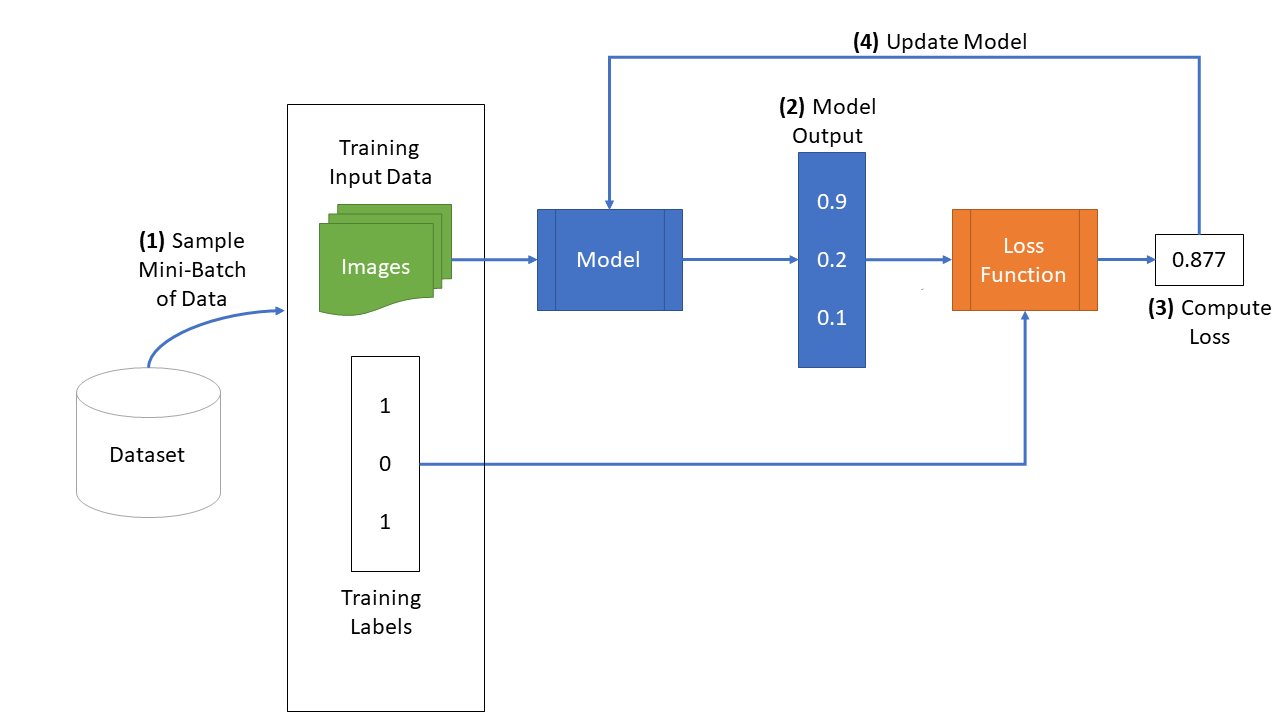Files already downloaded and verified
Files already downloaded and verified
Epoch 1: Train err: 0.446375, Train loss: 0.6813716783523559 |Validation err: 0.3865, Validation loss: 0.6602997500449419
Epoch 2: Train err: 0.37325, Train loss: 0.6497629323005676 |Validation err: 0.3845, Validation loss: 0.6575995869934559
Epoch 3: Train err: 0.359875, Train loss: 0.6388978385925292 |Validation err: 0.3495, Validation loss: 0.6291275043040514
Epoch 4: Train err: 0.346375, Train loss: 0.6246587996482849 |Validation err: 0.356, Validation loss: 0.6221408396959305
Epoch 5: Train err: 0.334375, Train loss: 0.6153830280303955 |Validation err: 0.3275, Validation loss: 0.6188967823982239
Epoch 6: Train err: 0.318, Train loss: 0.6036732516288758 |Validation err: 0.339, Validation loss: 0.6094125052914023
Epoch 7: Train err: 0.315625, Train loss: 0.5944745948314667 |Validation err: 0.329, Validation loss: 0.5974238961935043
Epoch 8: Train err: 0.3085, Train loss: 0.5829453563690186 |Validation err: 0.3085, Validation loss: 0.5885121468454599
Epoch 9: Train err: 0.302, Train loss: 0.5805657277107239 |Validation err: 0.3115, Validation loss: 0.5845186104997993
Epoch 10: Train err: 0.29975, Train loss: 0.573062111377716 |Validation err: 0.309, Validation loss: 0.5785001656040549
Epoch 11: Train err: 0.287375, Train loss: 0.5632161114215851 |Validation err: 0.314, Validation loss: 0.5821095015853643
Epoch 12: Train err: 0.292125, Train loss: 0.5567435595989227 |Validation err: 0.3115, Validation loss: 0.5860895598307252
Epoch 13: Train err: 0.2885, Train loss: 0.5562505607604981 |Validation err: 0.306, Validation loss: 0.5769414035603404
Epoch 14: Train err: 0.280375, Train loss: 0.5473350758552551 |Validation err: 0.3115, Validation loss: 0.5721263345330954
Epoch 15: Train err: 0.285, Train loss: 0.5481121215820313 |Validation err: 0.305, Validation loss: 0.5623639700934291
Epoch 16: Train err: 0.2915, Train loss: 0.5539557900428772 |Validation err: 0.3135, Validation loss: 0.5774335078895092
Epoch 17: Train err: 0.28075, Train loss: 0.5475348830223083 |Validation err: 0.2995, Validation loss: 0.5680588381364942
Epoch 18: Train err: 0.279625, Train loss: 0.5440063354969025 |Validation err: 0.319, Validation loss: 0.576342330314219
Epoch 19: Train err: 0.27575, Train loss: 0.5402116534709931 |Validation err: 0.3295, Validation loss: 0.606647988781333
Epoch 20: Train err: 0.2715, Train loss: 0.5385935208797454 |Validation err: 0.298, Validation loss: 0.5778946885839105
Epoch 21: Train err: 0.27575, Train loss: 0.540246558189392 |Validation err: 0.302, Validation loss: 0.5672952607274055
Epoch 22: Train err: 0.279, Train loss: 0.5399930019378663 |Validation err: 0.2895, Validation loss: 0.5702174408361316
Epoch 23: Train err: 0.27325, Train loss: 0.5354620461463928 |Validation err: 0.303, Validation loss: 0.5667499387636781
Epoch 24: Train err: 0.27275, Train loss: 0.5359286315441132 |Validation err: 0.301, Validation loss: 0.5878297919407487
Epoch 25: Train err: 0.27325, Train loss: 0.5346703794002533 |Validation err: 0.297, Validation loss: 0.563475382514298
Epoch 26: Train err: 0.27025, Train loss: 0.5316284673213959 |Validation err: 0.2985, Validation loss: 0.5694020707160234
Epoch 27: Train err: 0.270375, Train loss: 0.5298305144309997 |Validation err: 0.301, Validation loss: 0.578824263997376
Epoch 28: Train err: 0.269625, Train loss: 0.5351403400897979 |Validation err: 0.3005, Validation loss: 0.5655373437330127
Epoch 29: Train err: 0.271875, Train loss: 0.5319398436546325 |Validation err: 0.2955, Validation loss: 0.5849009975790977
Epoch 30: Train err: 0.270875, Train loss: 0.5373601081371308 |Validation err: 0.3175, Validation loss: 0.5815494349226356
Finished Training
Total time elapsed: 109.83 seconds
Files already downloaded and verified
Files already downloaded and verified
Epoch 1: Train err: 0.454375, Train loss: 0.6898944606781006 |Validation err: 0.4205, Validation loss: 0.6793290264904499
Epoch 2: Train err: 0.418875, Train loss: 0.6788924961090088 |Validation err: 0.4215, Validation loss: 0.6790428329259157
Epoch 3: Train err: 0.40525, Train loss: 0.6685061388015747 |Validation err: 0.3905, Validation loss: 0.6528578028082848
Epoch 4: Train err: 0.379125, Train loss: 0.6512472186088561 |Validation err: 0.3935, Validation loss: 0.6531118471175432
Epoch 5: Train err: 0.35525, Train loss: 0.6316115870475769 |Validation err: 0.3465, Validation loss: 0.6301526054739952
Epoch 6: Train err: 0.33675, Train loss: 0.6122225694656372 |Validation err: 0.352, Validation loss: 0.6261688079684973
Epoch 7: Train err: 0.3215, Train loss: 0.5984608561992645 |Validation err: 0.3475, Validation loss: 0.6187550257891417
Epoch 8: Train err: 0.31425, Train loss: 0.5851289410591125 |Validation err: 0.3205, Validation loss: 0.6030112085863948
Epoch 9: Train err: 0.3065, Train loss: 0.5784530780315399 |Validation err: 0.3205, Validation loss: 0.5930909719318151
Epoch 10: Train err: 0.29425, Train loss: 0.5654694662094116 |Validation err: 0.315, Validation loss: 0.5877073928713799
Epoch 11: Train err: 0.28075, Train loss: 0.553060997247696 |Validation err: 0.316, Validation loss: 0.595877917483449
Epoch 12: Train err: 0.278625, Train loss: 0.5416067514419556 |Validation err: 0.31, Validation loss: 0.5843141302466393
Epoch 13: Train err: 0.273375, Train loss: 0.5358790538311005 |Validation err: 0.2975, Validation loss: 0.5726522607728839
Epoch 14: Train err: 0.2685, Train loss: 0.5234937779903411 |Validation err: 0.2965, Validation loss: 0.5771211478859186
Epoch 15: Train err: 0.260125, Train loss: 0.5139133958816529 |Validation err: 0.2955, Validation loss: 0.5627784207463264
Epoch 16: Train err: 0.259375, Train loss: 0.5125633265972137 |Validation err: 0.3205, Validation loss: 0.58364431373775
Epoch 17: Train err: 0.24925, Train loss: 0.5033850579261779 |Validation err: 0.311, Validation loss: 0.5711408788338304
Epoch 18: Train err: 0.248125, Train loss: 0.4913763873577118 |Validation err: 0.296, Validation loss: 0.5609989166259766
Epoch 19: Train err: 0.23875, Train loss: 0.4821959674358368 |Validation err: 0.3045, Validation loss: 0.5786248967051506
Epoch 20: Train err: 0.23125, Train loss: 0.4757481541633606 |Validation err: 0.287, Validation loss: 0.580998913384974
Epoch 21: Train err: 0.22525, Train loss: 0.46251006150245666 |Validation err: 0.287, Validation loss: 0.5646722186356783
Epoch 22: Train err: 0.220375, Train loss: 0.4519791474342346 |Validation err: 0.2855, Validation loss: 0.5754687804728746
Epoch 23: Train err: 0.21375, Train loss: 0.44430874013900756 |Validation err: 0.288, Validation loss: 0.5742224156856537
Epoch 24: Train err: 0.207375, Train loss: 0.43036019349098203 |Validation err: 0.309, Validation loss: 0.6110728485509753
Epoch 25: Train err: 0.20175, Train loss: 0.4197188427448273 |Validation err: 0.2975, Validation loss: 0.5966625260189176
Epoch 26: Train err: 0.191125, Train loss: 0.4100140264034271 |Validation err: 0.2995, Validation loss: 0.6168392198160291
Epoch 27: Train err: 0.18725, Train loss: 0.4011841118335724 |Validation err: 0.3035, Validation loss: 0.6397394668310881
Epoch 28: Train err: 0.177375, Train loss: 0.38736681079864504 |Validation err: 0.3035, Validation loss: 0.614994109608233
Epoch 29: Train err: 0.170375, Train loss: 0.3770212644338608 |Validation err: 0.323, Validation loss: 0.7061460921540856
Epoch 30: Train err: 0.166125, Train loss: 0.3615760552883148 |Validation err: 0.3015, Validation loss: 0.6578065417706966
Finished Training
Total time elapsed: 122.63 seconds
